It is difficult to imagine the life of a car enthusiast without road signs. They are an essential element of traffic management. And the topic of traffic signs is very relevant for vehicles.
Let's try and figure out the most complex issues related to road signs.
Advantages and Benefits
Road signs- This is one of the most popular and convenient means of traffic control in the world (in general) and Russia (in particular). What gives them special value and significance?
Firstly, DZ very personable, and their large number makes it possible for traffic organizers to use them to achieve a wide variety of goals (to warn about something, to prohibit or prescribe something, to inform, etc.).
Secondly, they are quite clear. As a rule, it is not difficult to guess about the requirements put forward by the signs, because each of them represents a certain symbolism that is understandable to everyone.
Thirdly, remote sensing is not a particularly expensive way to organize traffic. Compared to markings, traffic lights and traffic controllers, the sign installation procedure is very economical.
Fourthly, this stable motion controller. While in winter the markings may be covered with snow, making them difficult to see, road signs do not have this drawback. The traffic light, in turn, requires a mandatory power supply, which may be disrupted (or not possible everywhere).
Fifthly, this the most durable means of regulation. If the markings tend to wear out and become indistinguishable, if the traffic light requires constant maintenance, if it cannot work without rest, then the road signs will function for a very long time.
These advantages indicate the special status of road signs in the practice of traffic regulation.
Groups of traffic signs
Purely for convenience and the clearest possible understanding by drivers of the principles of installation and operation, all road signs are divided into 8 main groups:
- Prescriptive.
- Special instructions.
- Informational.
- Service.
- Additional information (or signs).
And each group of signs performs strictly defined functions in the field of traffic regulation.
Brief description
Warning signs serve the function of informing drivers that they are approaching a dangerous section of the road. At the same time, the nature of the danger is reflected by the symbolism of the sign itself.
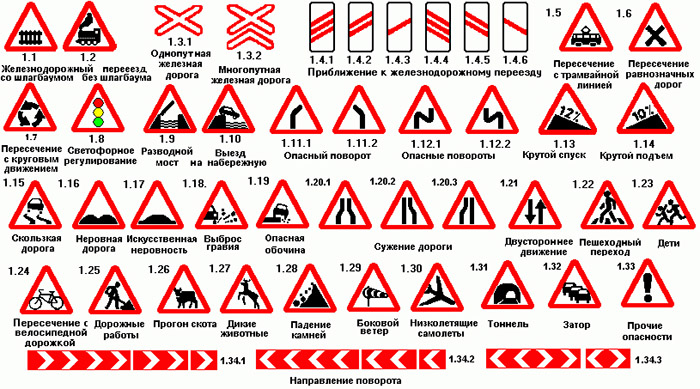
As a rule, warning signs do not oblige the driver to do anything, but justify the need to exercise attentiveness and caution. That is why almost all warning signs are installed in advance - at some distance before the start of the dangerous section of the road.
2. Priority signs
This group of signs is incredibly important. They indicate the order of passage of unregulated intersections, crossings, as well as narrow sections of the road where oncoming traffic is difficult or impossible.
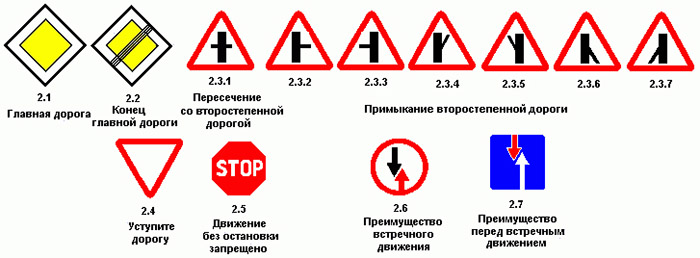
As practice shows, ignoring these signs is one of the most common reasons. That is why knowledge of the requirements that signs place on the driver, as well as strict compliance with their requirements, is the key to accident-free driving.
One of the most insidious and difficult to understand signs. And all because there are a lot of prohibitory signs. They also have a large number of exceptions to the general rules.
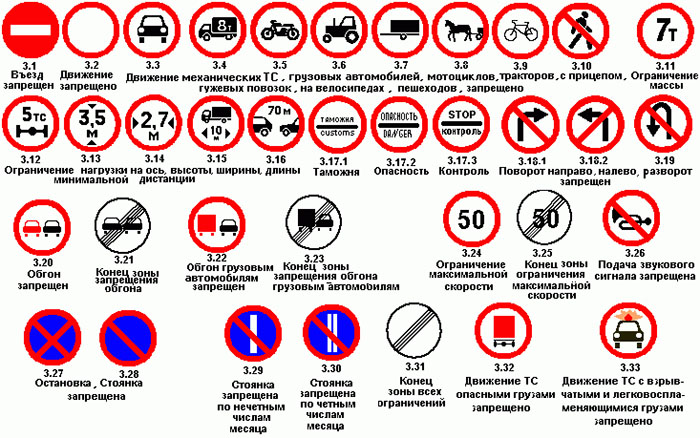
The purpose of prohibitory signs is to limit or exclude the movement of certain participants, to introduce restrictions on the direction of movement, speed, the performance of a number of maneuvers, etc. And in rare cases, to cancel previously introduced prohibitions.
Prohibition signs are very important to ensure traffic safety. That is why any violation of their requirements is punishable by the norms of administrative law of the Russian Federation.
Mandatory signs are intended to introduce or cancel traffic modes (speed, direction, etc.)
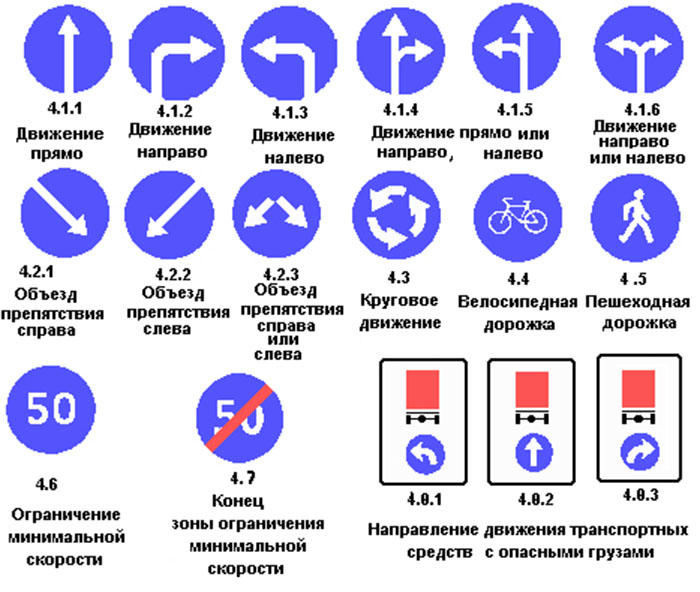
This group of road signs, prescribing a certain traffic mode, begins to resemble the action of prohibitory signs. And this is true. But with only one amendment: prohibitory signs introduce a negative (prohibitory) regulatory regime, and prescriptive signs introduce a positive one. In other words, prescriptive signs answer the question: “What should the driver do?”
The proximity of these signs to prohibition signs makes them very important in the organization of traffic and road safety.
These signs are very close to prescriptive signs. Of course, they even have the same root words in their names: “prescriptive”, “prescriptions”. And their purpose is also related: signs of special regulations are used to introduce special traffic modes or cancel such modes.
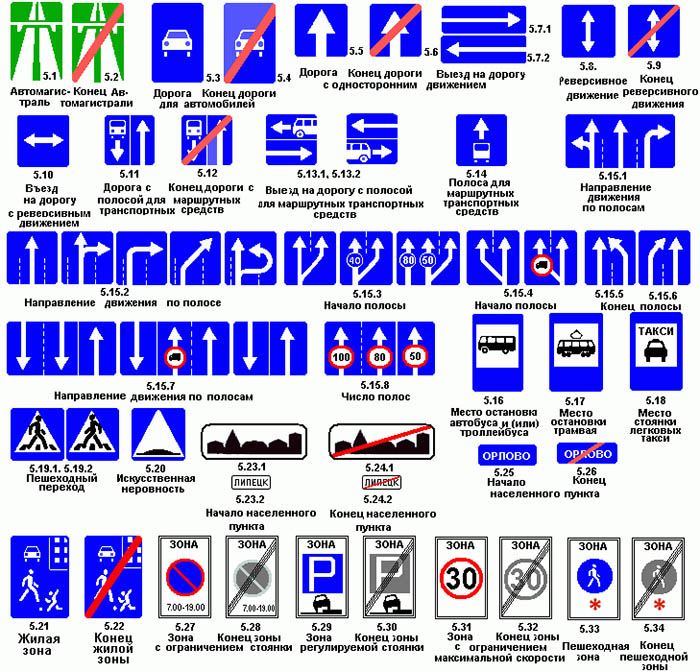
It is not for nothing that previously both prescriptive signs and signs of special instructions were included in a single group of directional signs. The difference between them is that prescriptive signs introduce one requirement, while the group we are interested in introduces several requirements at once. This makes special regulations signs a relevant means of regulating traffic.
The main purpose of information signs (judging even by the name of the group) is to inform road users about the location of various objects (mainly populated areas) and the distances to them. In addition, this very extensive group of signs also serves as a notification of established traffic modes.
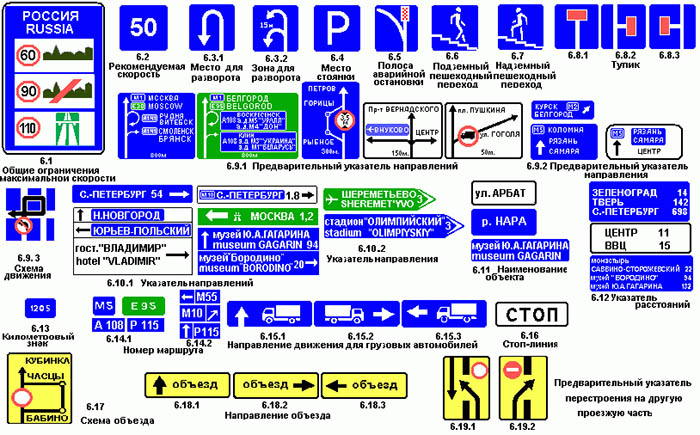
As a rule, drivers simply ignore information signs, considering them frivolous. And very much in vain! Firstly, among them there are also very insidious ones who not only inform, but also introduce a prohibitive regulatory regime. Secondly, information is never superfluous.
Although, in fairness, it should be said that compared to prohibitory and prescriptive signs, signs of priority and special instructions, this group is very harmless.
This is the most noble group of signs. Service signs notify the driver about the approach or location within the road of important road and other infrastructure facilities: hospitals, hotels, recreational facilities, service stations and other facilities.
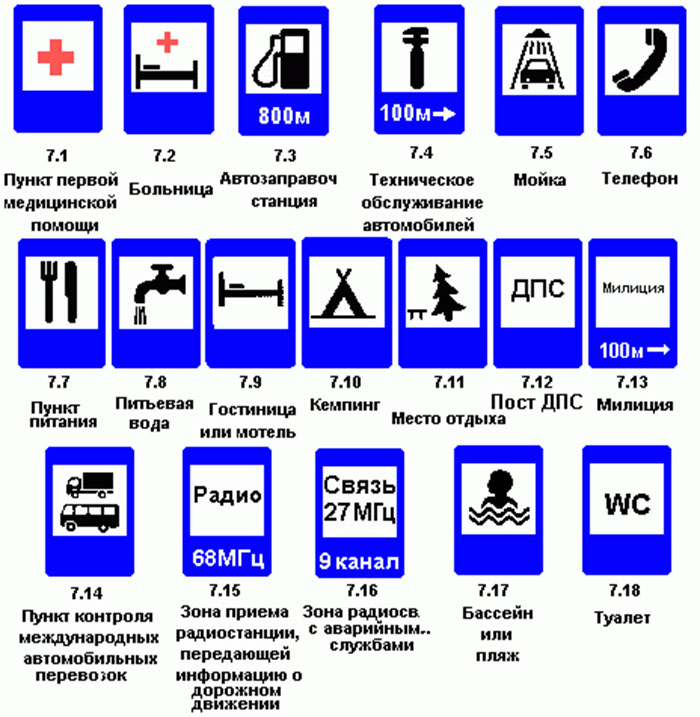
From the point of view of the requirements for drivers, service signs are the most harmless group. They do not demand anything from the driver at all, and therefore cannot become the reason for his punishment.
Despite the derogatory name - “plates” - these signs are very important in the road traffic system. Their goal is to complement, clarify, and limit the actions of other road signs.
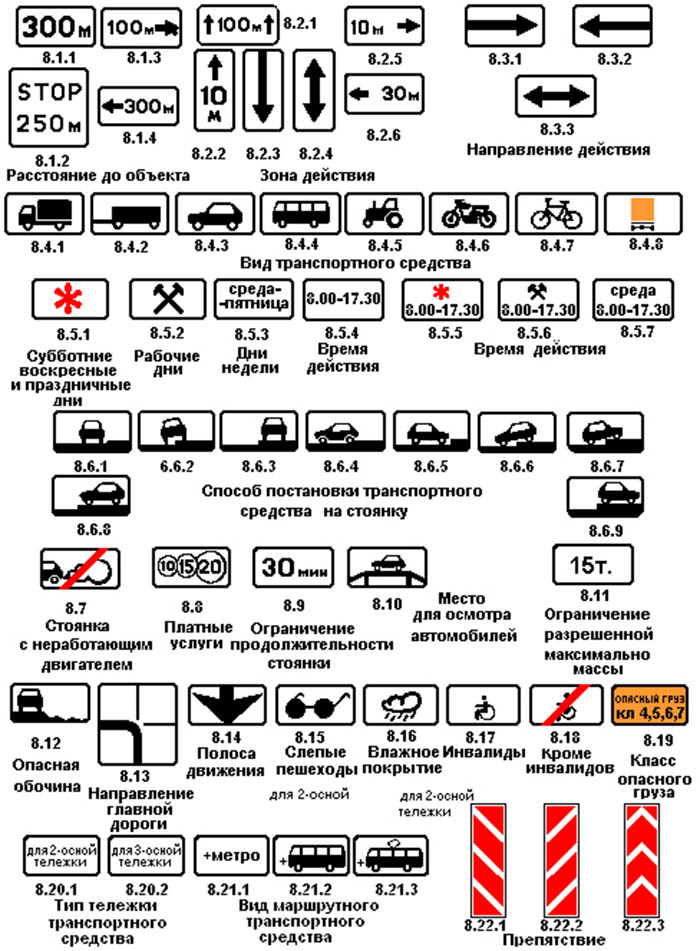
In other words, signs are never used independently. The fact is that they do not carry complete semantic information. The purpose of signs is to be in combination with other signs. But this is precisely what makes them an important means of organizing traffic.
Let's sum it up
It is unlikely that one should ask the questions: “Which signs are the most important? Which signs are not allowed and which ones can be ignored? It’s just that each group carries out its own – highly specialized and noble – mission in regulating traffic and ensuring the greatest safety of its participants.
Although it is worth saying (so as not to prevaricate) that the most important should be considered: 1) priority signs; 2) prohibition signs; 3) prescriptive. And to some extent signs of special instructions.
3 in 1: DVR + GPS informer + radar detector
How to protect yourself from the blinding sun and headlights while driving?
"Pedestrian crossing"- This is an informational sign.
It indicates the location of the ground crossing of the roadway. This sign is installed near special markings for pedestrians - zebra crossings.
Please pay attention to the child that there is another similar sign, but triangular. It is a warning (triangular) sign, also called a "Pedestrian Crossing". It does not indicate the crossing point for pedestrians, but warns the driver when approaching the crossing.
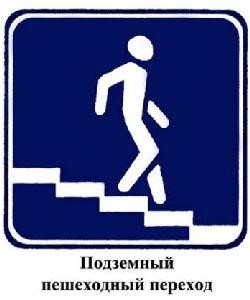
"Underground pedestrian crossing"- This is an informational sign. This sign indicates the location of the underground passage of the roadway. Installed near the entrance to the passage.
If you have an underground passage on the way to kindergarten or school, be sure to show it to your child.
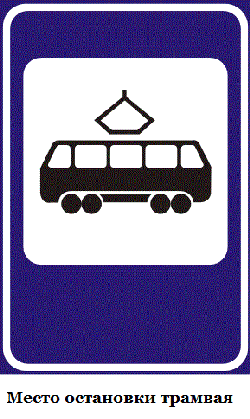
"Tram stop"- This is also an informational sign. He informs and points out to us that public transport stops at this location.
Parents should explain to the child that this road sign, like the previous one, is important for both pedestrians and drivers.
The pedestrian will find his way around where the stop is, and the driver will be careful, because there may be people (and especially children) at the stops.
When talking about this sign, be sure to repeat to your child how kids should behave at a stop (you can’t run or jump out onto the roadway).
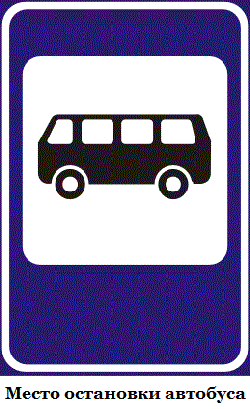
"Bus Stop Location"- This is also an informational sign. He informs and points out to us that a bus stops at this place.
This sign is installed close to the landing area - the waiting area for passengers.
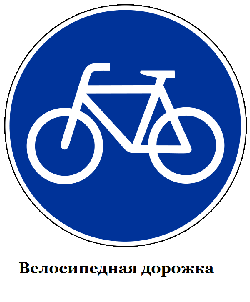
"Bike Lane"- this is a prescriptive sign. Allows movement only on bicycles and mopeds. Other types of transport are not allowed to enter it. Pedestrians can also use the bike path if there is no sidewalk or pedestrian path.
If your child already knows how to ride a bicycle, then you should explain to him that he can only ride his bicycle horse in the courtyard of the house. And the one where there is such a sign.
Bike paths are designed specifically for cyclists. Perhaps your city has such areas for cycling.
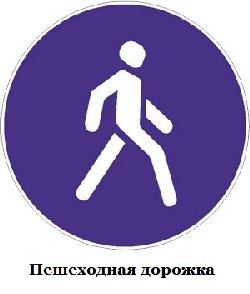
"Pedestrian path"- a prescriptive sign. Sometimes there is a special path on the streets intended only for pedestrians.
On this path you must follow general rules behavior for pedestrians: keep to the right; do not disturb other pedestrians.
Children should be explained that they are not allowed to play on the footpath or go sledding. Riding a bicycle on the pedestrian path is also prohibited.
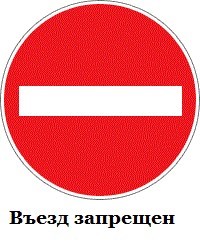
"No entry"- this is a prohibition sign. All prohibition signs are red.
This sign prohibits the entry of any vehicles, including bicycles, onto the section of road in front of which it is installed.
Its effect does not apply only to public transport, the routes of which pass through this section. A cyclist, upon seeing this sign, must get off the bicycle and drive it along the sidewalk, observing the rules for pedestrian traffic.
Remind your child that if he is carrying his bike rather than riding it, he is considered a pedestrian.
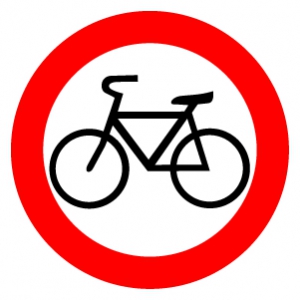
"Bicycles are prohibited"- another prohibitory sign.
This sign prohibits the use of bicycles and mopeds. It is installed in places where riding a bicycle can be dangerous.
Typically this sign is placed on streets with heavy traffic.
It should be remembered that cycling is prohibited on highways, even if there is no prohibiting sign.
I believe that every child should know this sign and the rules associated with cycling, because children love to ride and, if possible, will want to ride on the road.
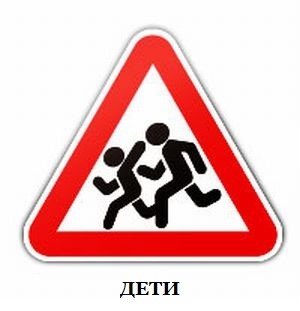
"Children"- warning sign.
This sign warns the driver about the possible appearance of children on the road. It is installed near a child care facility, for example, a school, health camp, playground.
But parents should warn the child that this sign does not indicate a place for children to cross the road! Therefore, a child pedestrian must cross the street in a place where pedestrian crossing is permitted and there is an appropriate sign.
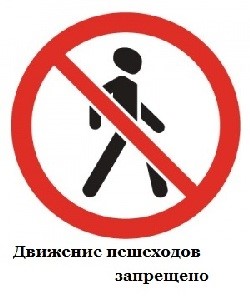
"No Pedestrians"- prohibition sign.
This sign prohibits the movement of pedestrians. It is installed in places where walking can be dangerous.
This sign is often used to temporarily restrict pedestrian traffic, for example, during road works or renovation of house facades.
It should be remembered that pedestrian traffic is always prohibited on highways and roadways, even if a prohibitory sign is not installed.
Even if you are not a driver and such a joyful event as obtaining a driver’s license is not expected in the near future, knowledge of road signs will not be superfluous. Moreover, they form an important part of the rules of the road traffic system and apply equally to all its participants.
Basically, road signs are presented in the form of standardized graphic drawings and are located either along roads or in places with a lot of people, for example, in a pedestrian crossing or subway. In addition, these are the main assistants in correct orientation on the roads and in the area.
Classification of road signs
The structure of road signs is clearly systematized and divides signs into eight groups, depending on their functions and semantic community.
So, the main types of signs are:
- warning;
- priority;
- prohibiting;
- prescriptive;
- particularly prescriptive;
- informational and indicative;
- service;
- additionally informative.
Each of these groups has its own characteristics and specific application.
- Warning signs. Shape: red triangle with white background. Well visible from afar. These signs are the safest and most useful because they are not restrictive or prohibitive. Their main function is notification of dangerous sections of the road, the nature of the potential threat and traffic difficulties, and warning against road accidents. Numbering starts with the number “1”.
- Priority signs. They come in different shapes and colors. There are only thirteen of them and therefore do not cause difficulties in remembering. A feature of priority signs is the determination of the priority right to cross roadways, intersections and narrow sections of roads. This group of signs includes: main road, movement without stopping is prohibited, priority of oncoming traffic, etc. Numbering starts with the number “2”.
- Prohibition signs. Mostly round shape with a black design on a white background and a serial number of category “3”. Meaning: prohibition certain actions on the road, introducing or canceling traffic restrictions. The most famous: “brick” (entry prohibited), prohibition of parking or stopping, overtaking, speed limit, etc.
- Mandatory signs. Also round in shape, but with white designs on a blue field. Group numbering starts with the number “4”. Function: indicating the direction of movement on certain sections of the road, limiting the minimum speed, warning about subsequent prohibition signs.
- Special instructions signs. Group numbering starts with "5". Few, but very significant. They combine elements of prohibitory and prescriptive signs. Meaning: entering or canceling some traffic modes, adjusting one-way traffic flow, designating a residential area, pedestrian crossing, priority of road lanes, and so on. Fines for violating these sign requirements directly depend on their type and range.
- Information and directional signs. In the shape of a square or rectangle with a blue border and a white/black design on a blue/white background. The group serial number is “6”. Responsible for informing all road users about populated areas, the nature of the road, the location of transport lanes, established travel modes and related recommendations.
- Service marks. The shape and color are the same as the information ones. The numbering starts with the number “7”. Function: information about various services and facilities - hotels, gas stations, campsites, cafes, etc. Signs are located at turns to the service location or directly next to them. Like category “6” signs, service signs also have exclusively informative value.
- Additional information signs. Presented in the form of rectangular plates with a black border and a pattern on a white background. The main purpose is to complement and clarify the actions of road signs from other categories. Never used on their own.
Road and children
With the help of this video, your child will be able to learn all the traffic signs.
A separate issue is to familiarize the child with the traffic rules. After all, as you know, traffic rules are not written for children and they think little about their own safety while moving across the road. This is why teaching them basic road signs from an early age is so important.
A truly children's sign warning of their appearance from the territory of an educational and similar institution adjacent directly to the road is the sign "Careful, children!"
It belongs to the warning group and should be taken into account not only by drivers, but also by children themselves, telling them that crossing the road in a given place is prohibited. In addition, similar stickers are used on public transport intended for transporting children.
Other most common signs for children are:
Sign "Pedestrian crossing" with a depicted zebra on it and indicating the location of the overpass of the roadway. However, the same sign, but in a red triangle, acts as a warning to the driver about approaching the crossing and the need to reduce speed. For a pedestrian, this is a clear signal that crossing the road at the location of the sign is prohibited.
Sign "Underground pedestrian crossing". It is installed at the entrance near the crossing, indicating the place of safe crossing of the street underground.
Sign “Tram/bus stop location”. Informs about the location of public transport stops and passengers' expectations.
Sign "Pedestrian path". Indicates a road intended for pedestrians only. The general rules of behavior for pedestrians apply.
Sign "No Pedestrians". The name of the sign speaks for itself. Installed in places where traffic may be unsafe. Often used to temporarily restrict movement.
Sign "Bike Lane" clearly indicates the road exclusively for bicycles and mopeds. Moving other types of transport here is strictly prohibited. In addition, this road can also be used by pedestrians, in the absence of a sidewalk.
Sign "Bicycles are prohibited". It speaks of the impossibility of using a bicycle for movement in this place. There is danger for cyclists on the road. When introducing a child to the principles of traffic and signs, it is necessary to pay great attention to the rules of behavior in public places, when crossing the street, waiting for transport, etc.
After all, extra vigilance is a sure guarantee of his safety!
Warning signs and their meaning
The table shows the warning signs that are most often found in urban areas.
| SIGN | NAME | MEANING |
|---|---|---|
| "Pedestrian crossing" | The possibility of a pedestrian appearing on the roadway. The need to reduce speed. Warning for crossing at a given point in the street. |
|
| "Children" | Possibility of sudden appearance of children on the road. | |
| "Men at work" | Carrying out repair or construction road work. Probability of special. technicians, workers, holes, potholes, etc. | |
| "Railway crossing with barrier" | Designation of the location of the barrier when crossing the roadway with railway tracks. | |
| "Railway crossing without a barrier" | Absence of a barrier at the intersection of the roadway with railway tracks. Additional attention should be paid when drivers and pedestrians cross the crossing. | |
| "Dangerous Turns" | There are several dangerous turns on the road. The bend of the line indicates the direction of the turns. | |
| "Rough Road" | There are various irregularities, potholes, holes, etc. on the road. | |
| "Slippery Road" | Slippery roads due to sleet, ice, rain or wet leaves. | |
| "Ejection of rocky materials" | Possibility of gravel, crushed stone, etc. being thrown out from under the wheels of a vehicle due to poor-quality road surface. | |
| "Emergency area" | Various types of danger on this section of the road. | |
| "Traffic Congestion" | Possibility of congestion and traffic jams in the area covered by this sign. | |
| "Rotation direction" | Warning about very sharp turns on the road. The direction of the arrows indicates the orientation. |
In addition, there are two special warning signs used in areas where there are embankments and bridges.
SIGN NAME MEANING
It should be remembered that ignorance of traffic rules does not relieve either drivers or pedestrians from responsibility. The latter, in case of traffic violations, also receive a fine.
Therefore, it is better to prevent such unpleasant situations and study the road rules and signs.
Didactic game on traffic rules for older preschoolers “Road Signs”
Netkacheva Elena Sergeevna, teacher, MBDOU Kindergarten No. 34 “Bell”, Mozdok, North Ossetia-Alania.
Description: given didactic game will be useful for educators and parents to study and reinforce road signs.
Age: The playbook is made for preschool children.
Goal and objectives: Teach and reinforce children's knowledge of road signs. Develop attention, thinking, memory.
Material: The game consists of cards and elements of road signs. Each card depicts a road sign, with its silhouette underneath the sign.
Progress of the game:
The game can be played by one, two or more people. The presenter conducts the game. The presenter talks about the meaning of each sign, or invites the children to remember and talk about them. Shows and explains their shape, color, name, purpose.
After explaining all the signs, the presenter distributes cards.
Then the presenter shows an element of a road sign and asks: “Which sign has the same element?”, “What is the name of this sign?”
If the answer is correct, the element is placed on the game card. The game is considered over if all participants in the game have filled out cards.
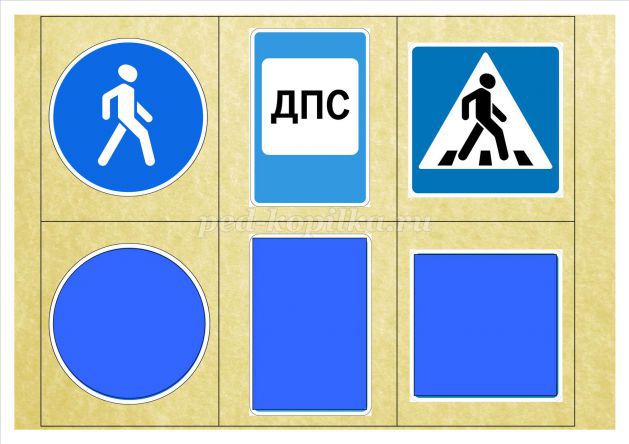
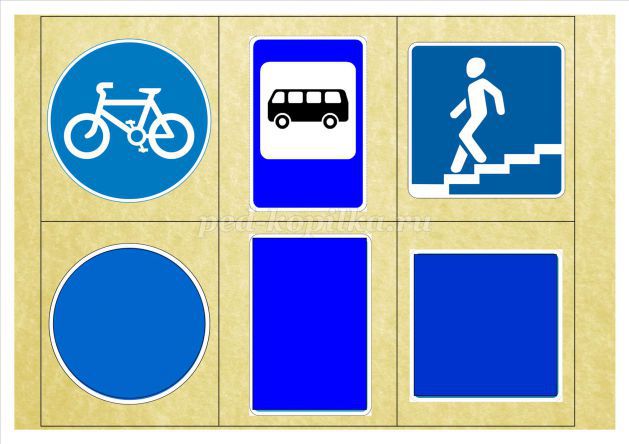
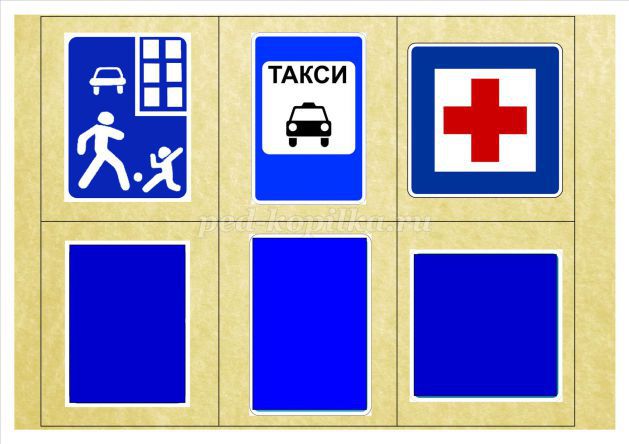
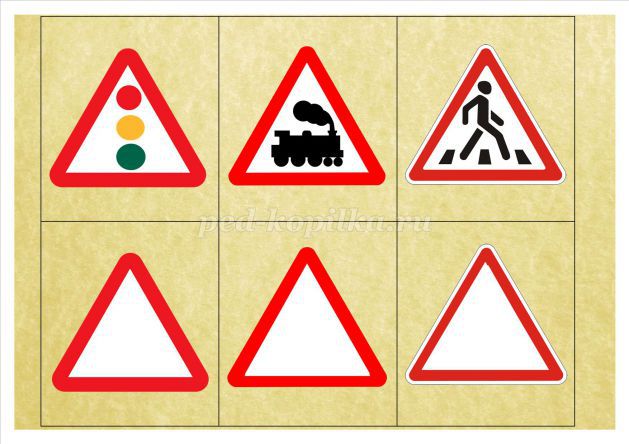
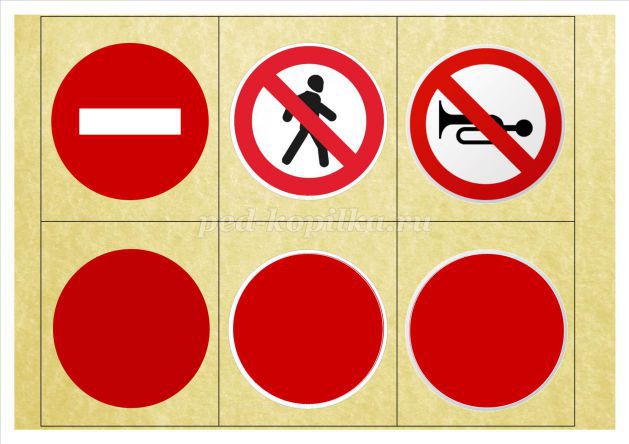
To make it easier for players during the game process, cards with signs can be cut.
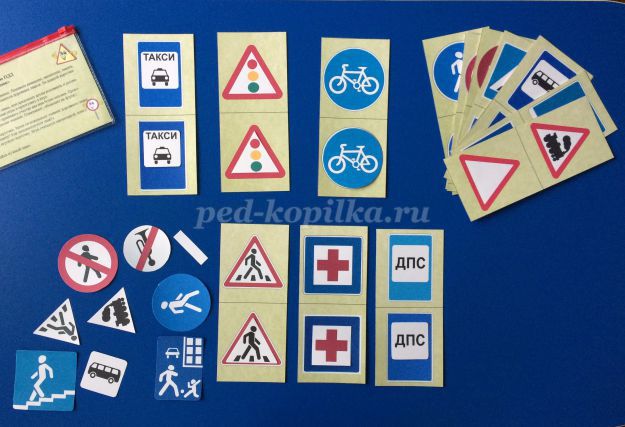
During the game, you can use Olesya Emelyanova’s material “Poems about road signs.” This will bring more interest to the game.
"No Entry" sign:
The driver's sign is intimidating
Cars are prohibited from entering!
Don't try rashly
Drive past the brick!
"No overtaking" sign:
Overtaking sign
Outlaws.
In this place, it is immediately clear
Overtaking others is dangerous!
Pedestrian crossing sign:
There's a land crossing here
People walk around all day.
You, driver, don't be sad,
Let the pedestrian pass!
“No driving without stopping” sign:
You, driver, take your time,
See the sign, stop!
Before you continue on your way,
Don't forget to look around.
Sign “Pedestrian traffic prohibited”:
In rain or shine
There are no pedestrians here.
The sign tells them one thing:
“You are not allowed to go!”
Sign “Underground pedestrian crossing”:
Every pedestrian knows
About this underground passage.
He doesn't decorate the city,
But it doesn’t interfere with cars!
Sign "Bus Stop Location"
trolleybus, tram and taxi":
There is a pedestrian in this place
The transport is waiting patiently.
He's tired of walking
Wants to become a passenger.
“No Sound Alarm” sign:
Hey driver, don't honk your horn
Don't wake up the sleeping ones with noise.
Don't scare passers-by with your horn,
After all, you yourself will go deaf too.
First aid station sign:
If someone breaks a leg,
Here doctors will always help.
First aid will be provided
They will tell you where to get treatment next.
Traffic light:
Every driver should know
What is the most important thing about a traffic light:
If he looks with a red eye,
Stop right away.
If a yellow eye flashes,
Wait, he will change now.
A green eye will light -
Feel free to go forward!
Is your baby growing up and are you thinking that soon you will need to let him go out alone? This means that you urgently need to teach him how to navigate the street and behave correctly on the road. To prevent learning from being boring and monotonous, we recommend presenting it to children in the form of a fun game. For example, you can offer your child Road signs coloring pages.
While coloring the pictures, tell your child what these signs are called, where they can be seen and what they are needed for. Tell us that road signs come in blue and red. The first ones prescribe how to behave in a given place, and the second ones prohibit some actions on a certain section of the road. Let the child compare how the meaning of the sign will change dramatically if it is painted in different colors(see coloring page "Signs for cyclists").
The most important thing your children need to learn with help is traffic signals. Explain to your child what their colors mean. An equally important sign is the “pedestrian crossing”. Every child should know that crossing the roadway is only possible in the place where this sign is installed and according to special markings on the road.
For Road signs coloring pages, it is better to choose paints. Since the signs are schematic and lack small details, even the most small child it won't be difficult. But the drawings will turn out bright and memorable.
An excellent tool for a child's first acquaintance with the basics of traffic rules. In addition, it is also a pleasant pastime, because coloring is also creativity. Let your child choose the color of paint. To make the drawing clear, have the child outline the outlines of the coloring details in black.
WITH Road signs coloring pages from this section your child will easily and naturally remember important rules Traffic rules, but it would not be superfluous to repeat the learned material once again, considering. Only by thoroughly examining and teaching your child the basics of behavior on and near the roadway will you be calm about the safety of your child on the street.
Road signs coloring pages in this section:
- Sign Pedestrian crossing - road signs
- Coloring pages Road signs - Underpass
- Traffic light coloring page - road signs
- Coloring pages Road signs - No entry
- Signs for cyclists in coloring pages Road signs



